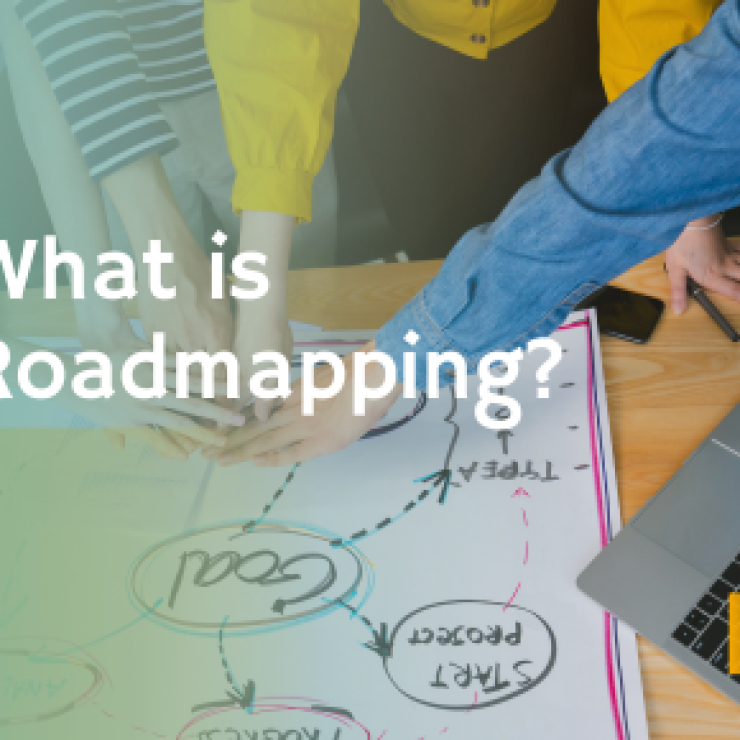In the dynamic landscape of technological advancements, software development has become a cornerstone of countless industries. A vital component underpinning this development process is the software roadmap—a strategic planning instrument that streamlines decision-making, fosters effective communication, and cultivates a harmonious understanding of objectives among team members.
Through this comprehensive guide, we aim to delve into the intricacies of the software roadmap, elucidating its purpose, structure, and importance in successful project management. Join us as we navigate the roadmap to developing superior software solutions.
What is a Software Roadmap?
A software roadmap is a strategic planning tool used in the field of software development. It serves as a visual guide that illustrates the vision and direction of a software product or system over a specified period. In essence, it’s a blueprint outlining what the team aims to achieve and how they plan to do so.
A software roadmap offers an overview of the key milestones, features, enhancements, and tasks that are to be tackled in the product’s lifecycle. These elements are typically presented in a chronological manner, providing clear timelines and a sense of direction.
The purpose of a software roadmap extends beyond mere planning. It also plays a crucial role in aligning the development team and stakeholders—such as management, clients, or users—with the product’s strategic vision. By defining the goals and the path to reach them, it helps manage expectations, aids in decision-making, and promotes transparency and communication within the team.
However, it’s essential to remember that a software roadmap is not set in stone. It is flexible and can be adapted or changed based on new information, shifting priorities, or changes in the business environment. This ability to adjust and realign makes it a powerful tool in agile environments, where responsiveness to change is highly valued.
To summarize, a software roadmap is a strategic tool that provides a bird’s eye view of a software project, detailing its vision, direction, key deliverables, and timelines, while aligning all stakeholders on the product’s path forward.
The Purpose and Objectives of a Software Roadmap
A software roadmap serves several critical purposes and objectives within the realm of software development:
- Clear Direction: It provides a clear direction for the project, ensuring all stakeholders understand the vision, goals, and strategic priorities.
- Guided Decision-Making: The roadmap aids in decision-making by illustrating the prioritized features and enhancements, allowing teams to understand where to focus their efforts.
- Stakeholder Alignment: By visualizing the timeline and key milestones, a roadmap aligns all stakeholders, including developers, managers, clients, and end-users, on the project’s course.
- Resource Management: A software roadmap helps with resource allocation, enabling project managers to efficiently assign tasks and distribute workload according to the timeline and priorities.
- Expectation Management: The roadmap effectively communicates what stakeholders can expect and when, reducing potential misunderstandings or miscommunications.
- Flexibility and Adaptability: Given its dynamic nature, a software roadmap can adapt to changes, whether these are alterations in business objectives, market conditions, or customer feedback. It ensures the project stays relevant and competitive.
Core Elements of a Software Roadmap
A well-designed software roadmap consists of several key components:
- Goals and Objectives: These are the strategic aims that the software product aims to fulfill. They provide the purpose and direction for the roadmap.
- Features and Enhancements: The roadmap should list the major features and enhancements planned for the software, preferably prioritized based on their importance or their strategic alignment with the project’s objectives.
- Timeline: A clear timeline, complete with milestones, gives the roadmap its structure. This allows everyone involved to understand the sequence of tasks and the expected delivery dates.
- Resources: This includes human resources (i.e., team members and their roles) as well as other resources, such as budget and equipment. It outlines who will be working on what and when, facilitating efficient resource allocation.
- Stakeholder Input: Stakeholder feedback, expectations, and needs should be incorporated into the roadmap to ensure the end product aligns with their requirements.
- Risks and Dependencies: Identifying potential obstacles or dependencies between tasks can help preemptively address issues that might delay the project.
These elements form the backbone of a software roadmap, providing a comprehensive and cohesive view of the project’s path.
Types of Software Roadmaps
Software roadmaps can take various forms, each catering to a specific aspect of the software development lifecycle. Here are the most common types:
Product Roadmap:
A product roadmap outlines the strategic direction and planned evolution of a software product over time. It clearly lays out the upcoming features, improvements, and milestones linked to the product’s development.
This roadmap is typically audience-specific and can be used to communicate product strategy to different stakeholders such as executive leadership, development teams, sales teams, and even customers.
Project Roadmap:
A project roadmap is a high-level overview of a project’s key objectives and deliverables, along with their respective timelines.
Unlike the product roadmap, which is centered around the product’s features, a project roadmap emphasizes the specific tasks or activities that need to be completed to reach the end goal. It’s an effective tool to communicate the overall project plan and progress to stakeholders.
Technology Roadmap:
Also known as IT or technical roadmap, this type focuses on the technology strategy of an organization. It presents an overview of the current technological infrastructure, the tech-related goals, and the path to achieve them.
The technology roadmap might include new technologies to be adopted, technical debts to be resolved, infrastructure upgrades, or security improvements.
Release Roadmap:
A release roadmap provides a timeline of when product updates or new features will be launched. This roadmap is particularly useful for coordinating release schedules across different teams, managing marketing and sales expectations, and informing clients or users about upcoming updates.
Strategy Roadmap:
A strategy roadmap communicates the strategic vision of the organization or product. It displays the strategic goals and the initiatives to achieve them, aligning them with the business’s overall objectives.
While it may not delve into the specifics of features or technical requirements, it gives stakeholders a clear understanding of the product’s strategic direction.
Each type of roadmap serves a different purpose and audience but they all offer a clear, visual representation of plans and expectations. It’s not uncommon for organizations to use multiple types of roadmaps to cater to various needs within the software development process.
How to Create a Software Roadmap
Creating a software roadmap involves a series of steps, each crucial to developing a comprehensive and effective plan. Here’s a breakdown of each step:
A. Determining the Goals and Objectives
The first step in creating a software roadmap is defining what you want to achieve—your goals and objectives. These could range from improving user experience, expanding market reach, addressing technical debt, to enhancing specific features.
Your goals should be specific, measurable, achievable, relevant, and time-bound (SMART) to ensure they drive actionable strategies. Furthermore, they should align with your business strategy, as they form the foundation upon which the rest of the roadmap is built.
B. Gathering Input and Requirements
Next, it’s time to gather input from various stakeholders, including customers, development teams, management, and sales and marketing teams. Stakeholder input ensures the roadmap reflects diverse perspectives and needs.
This can include identifying necessary features, understanding user pain points, considering technical constraints, and acknowledging market trends. User stories, customer feedback, and market research can be invaluable at this stage.
C. Prioritizing Features or Projects
After gathering requirements, you’ll likely have a long list of potential features or projects. However, due to time and resource constraints, not everything can be implemented at once. Therefore, it’s crucial to prioritize.
Consider factors such as strategic alignment, impact on users, cost, and effort to implement. Tools like a weighted scoring model or the MoSCoW method (Must have, Should have, Could have, Won’t have) can help with prioritization.
D. Plotting the Timeline and Milestones
With your prioritized list, you can now begin to plot your timeline. A timeline illustrates when work will begin on specific features or projects and when they’re expected to be completed.
It also outlines key milestones—significant points in the project that indicate progress. Your timeline should be realistic, factoring in potential delays and dependencies between tasks.
E. Allocating Resources
Resource allocation involves deciding how your resources—such as personnel, budget, and tools—are distributed across the projects or features on your roadmap.
Effective resource allocation ensures that every item on the roadmap has the necessary resources to reach completion. This also involves defining roles and responsibilities to ensure everyone knows what part they play in the project.
F. Incorporating Feedback and Revisions
Finally, remember that a software roadmap isn’t a one-and-done document. It should evolve as circumstances change. This means regularly reviewing the roadmap, incorporating new information, and making revisions as necessary.
Stakeholder feedback, changes in market trends, project progress, and lessons learned are all valuable sources of information that can influence updates to your roadmap.
The Role of a Software Roadmap in Agile Development
A. Introduction to Agile Development
Agile Development is a method of software development that emphasizes flexibility, collaboration, customer involvement, and incremental delivery.
Rather than planning the entire project upfront and executing it in a linear fashion (like in the traditional Waterfall method), Agile breaks down the project into smaller, manageable pieces—often referred to as ‘sprints’ or ‘iterations.’
Each sprint delivers a workable product that can be reviewed, tested, and improved upon, facilitating constant feedback and adaptation.
B. The Connection Between Agile and Software Roadmaps
At first glance, Agile and software roadmaps may seem incompatible. Agile values flexibility and responsiveness to change, while a roadmap seems to suggest a fixed plan. However, this isn’t the case.
A well-designed software roadmap is not set in stone; it’s a dynamic tool that evolves as circumstances change. This characteristic aligns perfectly with the Agile philosophy.
In an Agile environment, a software roadmap provides a high-level view of the product’s direction, offering context for the work being done in each sprint. It maps out the overall strategy, goals, and major features or enhancements, which can then be broken down into tasks to be tackled in sprints.
The roadmap keeps the Agile team aligned on the big picture, even as they work on individual iterations.
C. How a Software Roadmap Enhances Agile Processes
A software roadmap enhances Agile processes in several ways:
- Aligns the Team on Strategy: While Agile teams work on individual sprints, a roadmap ensures that everyone understands the overall strategy, keeping the team aligned on the product’s long-term vision.
- Guides Prioritization: A roadmap helps Agile teams understand the priority of features or enhancements, informing the planning of sprints.
- Facilitates Stakeholder Communication: Roadmaps provide a way for Agile teams to communicate their plans and progress to stakeholders. This helps manage expectations and fosters trust in the Agile process.
- Promotes Adaptability: A dynamic roadmap can be updated based on feedback from each sprint, ensuring the product remains responsive to user needs or market changes.
In essence, a software roadmap doesn’t contradict Agile principles; instead, it supports them by providing strategic guidance, fostering alignment, and promoting adaptability. This makes it an invaluable tool in Agile software development.
Best Practices for Developing a Software Roadmap
A. Regular Updates and Revisions
One of the best practices for developing a software roadmap is to treat it as a living document. This means it should be regularly reviewed and updated to reflect new information, changing priorities, or alterations in the business environment.
This practice aligns the roadmap with Agile principles, ensuring it remains flexible and adaptable. Moreover, regular revisions ensure the roadmap accurately represents the current state of the project, contributing to more effective planning and decision-making.
B. Transparent Communication with Stakeholders
A software roadmap is as much a communication tool as it is a planning tool. It should be used to clearly and transparently communicate the software’s direction, goals, and progress to all stakeholders.
This includes not only the development team but also project managers, executives, clients, or even end-users. Regular updates, presentations, or roadmap discussions can be used to keep everyone informed.
Transparency in communication helps manage expectations, align everyone on the project’s direction, and foster trust among stakeholders.
C. Balancing the Needs of Different Stakeholders
Different stakeholders will have different needs, perspectives, and priorities. For instance, the development team may be focused on technical debt, users might be interested in new features, while executives could be concerned about strategic alignment.
A well-crafted software roadmap should balance these diverse needs. This often involves prioritization, negotiation, and sometimes making tough decisions.
But the result is a roadmap that takes into account a broad range of inputs, making the end product more robust and more likely to satisfy all stakeholders.
D. Avoiding Over-complication
While it’s important for a software roadmap to be comprehensive, it should not be overly complicated. A roadmap cluttered with too much detail can be difficult to understand and manage, defeating its purpose of providing a clear, visual representation of the software’s direction.
The best roadmaps often focus on major features, key milestones, and strategic goals. Details about specific tasks or technical implementation can be left for project plans or sprint backlogs. Remember, simplicity and clarity should be the guiding principles when creating a software roadmap.
Common Pitfalls and How to Avoid Them
Navigating the complexities of a software roadmap can sometimes lead to common pitfalls. Recognizing these pitfalls and understanding how to avoid them is vital for successful roadmap management.
A. Over-promising and Under-delivering
One of the most common pitfalls in roadmap planning is over-promising and under-delivering. This happens when too many features or overly ambitious timelines are included in the roadmap, leading to missed deadlines or poorly developed features.
Solution: To avoid this, it’s essential to be realistic when planning your roadmap. Make sure to consider the resources available, potential dependencies or risks, and the complexity of tasks. Using historical data on your team’s velocity can also help predict how much work can be done in a given timeframe. Finally, under-promise and over-deliver whenever possible to exceed stakeholder expectations.
B. Lack of Flexibility and Adaptability
A software roadmap that is too rigid and unable to adapt to changes can quickly become outdated and ineffective. In the fast-paced world of software development, changes in market trends, customer needs, or business objectives are inevitable.
Solution: To combat this, build flexibility into your roadmap from the start. Regularly review and update your roadmap, and be open to changes when necessary. Adopting Agile principles can also enhance adaptability, allowing your roadmap to evolve based on feedback from each sprint or iteration.
C. Ignoring Stakeholder Feedback
Ignoring feedback from stakeholders is another common pitfall. Stakeholders—from customers and end-users to developers and executives—can provide valuable insights that can influence the roadmap.
Solution: Actively seek out and incorporate stakeholder feedback into your roadmap. This can involve user surveys, feedback sessions, or regular meetings with different stakeholder groups. Remember, a software roadmap should be a collaborative tool, reflecting the needs and input of all stakeholders.
D. Practical Solutions to These Problems
The practical solutions to these problems ultimately lie in adopting best practices for roadmap management:
- Be realistic and conservative in your planning to avoid over-promising.
- Foster a culture of flexibility and adaptability, allowing your roadmap to evolve with changing circumstances.
- Promote active communication and collaboration with stakeholders to ensure their input is considered.
By avoiding these common pitfalls, you can enhance the effectiveness of your software roadmap, making it a powerful tool for strategic planning, communication, and alignment in your software development process.
Conclusion
In conclusion, a software roadmap is a powerful strategic tool that provides a high-level overview of a software product’s direction. It aligns teams with the product’s vision, facilitates prioritization of features, enhances stakeholder communication, and promotes adaptability, making it particularly useful in Agile development environments.
While creating a software roadmap involves various steps—from defining goals to gathering requirements, prioritizing tasks, plotting timelines, allocating resources, and incorporating revisions—each step plays a crucial role in crafting a roadmap that truly reflects the product’s journey.
Moreover, using different types of roadmaps, including product, project, technology, release, and strategy roadmaps, can cater to various needs within the software development process, ensuring all aspects of the software’s evolution are effectively managed.
However, developing an effective software roadmap requires careful attention to best practices. Regular updates, transparent communication, balancing stakeholder needs, and maintaining simplicity can make the difference between a useful roadmap and a mere document. Additionally, avoiding common pitfalls like over-promising, lack of flexibility, and ignoring stakeholder feedback can enhance the success of your roadmap.
Ultimately, a well-crafted software roadmap can drive alignment, foster strategic decision-making, and act as a guiding beacon in your software development journey. Its importance cannot be overstated, making the investment in its creation and management well worth the effort.




